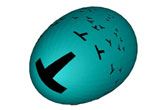Speed Reading Just a Gimmick

When you read, your eyes act like spotlights on a stage. The construction of your eyes only allows them to focus on one small area on the page at a time, so the idea of speed reading is bunk, according to several studies published in the Journal of Vision this month.
Although you might have the illusion that you see the whole page, you can actually only see small groups of letters at the point where your eyes are focused. Only eight or 10 letters fit in this tiny window, called the visual span. The rest of the letters are just a blur, said Gordon Legge, a vision researcher at the University of Minnesota.
So how does anyone ever finish a book as long as "War and Peace?" Readers make a series of eye movements while scanning the page, Legge said.
People typically make four eye movements per second, picking up about four or five words per second and 250 to 300 words per minute. That's a typical estimate for normal reading speed, Legge said.
Because of the constraints of the visual span, reading more than 300 words per minute is almost impossible.
"Speed reading is misleading," said Legge, whose research is published in the March issue of the Journal of Vision. "There's no magic there. You're just planting the little island of vision quickly through the page."
Shrinking window
Sign up for the Live Science daily newsletter now
Get the world’s most fascinating discoveries delivered straight to your inbox.
When viewing conditions are less than ideal, the visual window shrinks, Legge said.
For instance, people with macular degeneration—the leading cause of vision loss in Americans aged 65 or older—read more slowly than people with healthy eyes, even if they're handed a magnifying glass. The disease affects the macula, part of the retina responsible for central, sharp vision, and forces people to rely on their cloudy peripheral vision [image].
In laboratory experiments, Legge and his colleagues tested how changing different aspects of the visual span, such as character size and contrast, affected the speed at which people read. Reading small print, print with poor contrast, or print with strange spacing also leads to slower reading, Legge told LiveScience.
On the brain
The visual window limits the ability to see things beyond just letters and words, such as icons on a computer desktop or Waldo in a "Where's Waldo" puzzle. In a second study published in the journal, scientists have plotted how these visual scenes appear on the brain.
The sharpest vision occurs in the fovea, the center of the macula where receptors in the eye's retina are most tightly packed. This information is then sent to the primary visual cortex in the brain.
"The differing densities of the receptors in the retina are mapped in the brain onto the primary visual cortex in such a way that it's stretched so that a lot more cortex is dedicated to the fovea than the periphery," said Brad Motter, a neuroscientist at the Veterans Affairs Medical Center in Syracuse.
The objects we look at appear on the surface of the brain in decreasing size, where the focal point is greatly magnified, and the objects farther away are smaller, Motter told LiveScience [image].
As in a "Where's Waldo" puzzle, crowded objects limit our ability to find targets in the visual scene.
Motter, along with his colleague, Diglio Simoni, looked specifically at people's ability to search for images on a computer screen. They showed that the proximity of objects that surround what a viewer is trying to focus on also determines how quickly a viewer can search out the target object.
"We found that finding the target was dependent on the density of things on the screen," Motter said.












